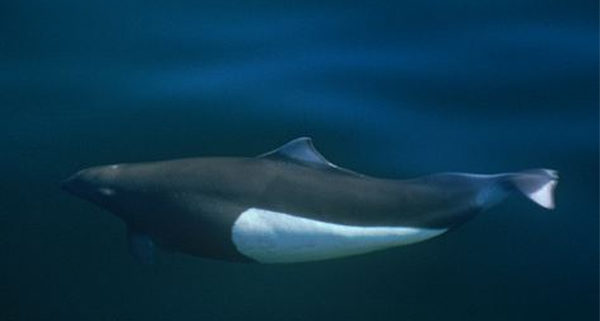Dall’s Porpoise Common Name: Dall’s Porpoise Scientific Name: Phocoenoides dalli Size Range: Males length – Average 1.8 m, Maximum – 2.29m Female’s length – Average 1.8 m, Maximum- 2.1m They weigh around 220kg (480pounds) Identifying features The Dall’s Porpoise has a small head with a narrow mouth and small flippers. They have a forward tilted dorsal fin that has a small white trim. The tail of the Dall’s porpoise usually has a white strip. The most common way to identify them is by the large white flank on the stomachs. Habitat The Dall’s Porpoise has a wide range in habitat. They are usually found in water at least 1000 kilometers from shore. They can also be found in sounds, near shore waters (near deep water canyons). They like water that is colder than 18◦C and they are most abundant in waters colder than 13◦C. They are found in waters between 3-20◦C. They appear to prefer waters that are 600ft and deeper. Dall’s porpoises live throughout the North Pacific, along the North American coasts of California, Canada, and Alaska, and the Asian coasts of Japan, Korea, and Russia. Prey The Dall’s Porpoise doesn’t have a specific food group. Their diet depends on where they live. They eat a wide range of fish and squid in the open ocean and schooling fish in coastal areas. They generally feed at night and eat from 28-30 pounds of food which is 12.7-13.5kg! Predators Given the size and speed of the Dall’s Porpoise, they are very difficult to catch. Their main predators are Killer Whales and sharks. They largely escape predation because of their color which makes them hard to see and their ability to travel in groups. Life Cycle The Dall’s Porpoise reaches sexual maturity at around 8 years old. They give birth primarily in the summer. Calves are nursed until they are 2 years old. The Dall’s Porpoise doesn’t usually live longer than 20 years. Behaviour The Dall’s Porpoise usually swims in groups of 15-20 porpoises. They stick to these groups and hunt together, however when groups join you can have groups with thousands of porpoises. The other animals that they can be seen associating with are the Pacific White-sided Dolphins and the Pilot Whales. Photos provided courtesy of Joe McDonald from the ARKive of life website at www.arkive.org
References Culik, B (2010) Whales and Dolphins. Dall’s Porpoise. Retrieved May 9, 2012 from http://www.cms.int/reports/small_cetaceans/data/P_dalli/p_dalli.htm Decker, J. (2002) Animal Diversity Web. Dall’s Porpoise. Retrieved May 9, 2012 from http://animaldiversity.ummz.umich.edu/site/accounts/information/Phocoenoides_dalli.html Houck, W.J. and T.A. Jefferson. (1999) Handbook of Marine Mammals Volume 6: The Second Book of Dolphins and the Porpoises. Academic Press, San Diego Kids do Ecology (2004) Marine Mammals. Dall’s Porpoise. Retrieved May 9, 2012 from http://kids.nceas.ucsb.edu/mmp/Dall.html Marine Bio. (2009) Dall’s Porpoise. Marine Bio. Retrieved May 9, 2012 from http://marinebio.org/species.asp?id=363 Nahmens, J. (2002). All about the Dall’s Porpoise. The Dall’s Porpoise. Retrieved May 9, 2012 from http://dallsporpoise.org/about.htm The Pacific wildlife Foundation. (2011) Dall’s Porpoise. Dall’s Porpoise. Retrieved May 9, 2012 from http://www.pwlf.org/dallsporpoise/photos.htm Willis, P.M. (2004) Natural hybridization between Dall’s porpoises (Phocoenoides dalli) and harbour porpoises (Phocoena phocoena). Canada, Canadian Journal of Zoology Wilson, D. E. and S. Ruff. (1999) The Smithsonian book of mammals. Smithsonian Institution, Washington DC.
Author: Maisha Moon




Leave a Reply
Want to join the discussion?Feel free to contribute!